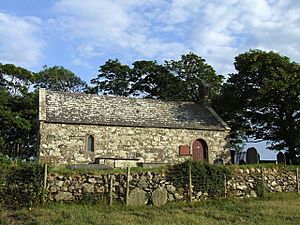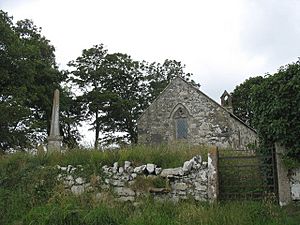St Ceidio's Church, Rhodogeidio facts for kids
Quick facts for kids St Ceidio's Church, Rhodogeidio |
|
|---|---|

The north side of the church
|
|
| Lua error in Module:Location_map at line 420: attempt to index field 'wikibase' (a nil value). | |
| OS grid reference | SH 411 854 |
| Location | Rhodogeidio, near Llannerch-y-medd, Anglesey |
| Country | Wales, United Kingdom |
| History | |
| Status | Church |
| Founded | 7th century (first church) Present structure 1845, on the site of a 14th-century church |
| Dedication | St Ceidio |
| Architecture | |
| Functional status | Disused |
| Heritage designation | Grade II |
| Designated | 12 May 1970 |
| Specifications | |
| Materials | Rubble masonry, slate roof |
St Ceidio's Church, Rhodogeidio is an old church located in the countryside near Llannerch-y-medd in Anglesey, north Wales. It was built in the 1800s, but it used stones from an even older church from the 1300s. People have been worshipping on this spot since the 600s!
Even though the church is not used for regular services anymore, local people have taken good care of it. Inside, you can see a window from the 1300s and a special basin for baptisms (called a font) from the 1400s.
This church is a Grade II listed building. This means it's a very important historical building that should be protected. It's special because it looks a lot like the medieval church that stood there before.
Contents
History of St Ceidio's Church
The church is named after St Ceidio, a Welsh saint from the 500s. He started many churches in Wales. Experts believe that a church has been on this site since the 600s. One historian even suggested it was as early as 630 AD.
The church you see today was rebuilt in 1845. It used the original foundations and many of the same stones from the 1300s church. A local church leader, Hugh Wynne Jones, oversaw the rebuilding.
Long ago, St Ceidio's Church was a "chapel of ease" for another church nearby, Llantrisant church. This meant it was a smaller church built for people who lived far from the main church. Later, in the 1400s, St Mary's Church, Rhodogeidio was built to help St Ceidio's.
St Ceidio's Church has not been used for regular services for many years. However, people in the area have worked hard to restore and look after it. St Mary's Church, which is about a mile away, is now in ruins.
Location and Surroundings
St Ceidio's Church is in a quiet countryside area. It is about one mile northwest of Llannerch-y-medd. The church sits within a raised, circular churchyard. This type of churchyard is called a llan in Welsh.
The name of the area, "Rhodogeidio," comes from the church itself. "Rhod-" might mean "defended mound," and "-geidio" is a form of the saint's name. So, it means "the defended mound of Ceidio."
Architecture and Inside the Church
St Ceidio's Church is built from rough stones called rubble masonry. It has a roof made of slate. At the west end of the church, there is a stone structure from the 1800s called a bellcote, where a bell would have been. Inside, you can see the wooden beams that support the roof.
You enter the church through a rounded doorway on the north side. Some experts think this doorway is from the 1300s, while others believe it might be from the 1600s. Inside, the main part of the church (the nave) flows directly into the altar area (the chancel) with just one step separating them.
There are four windows in the church, all with clear glass. The oldest window is at the east end and dates back to the 1300s. It has one main section of glass and some decorative stone patterns (called tracery) at the top. The other three windows, two on the south wall and one on the north wall, are from the 1800s. They are rectangular and have a three-leaf shape (a trefoil) at the top.
The wooden benches (pews) and the raised platform for the speaker (pulpit) are from the 1800s. You can also see marble plaques on the walls that remember people from the 1700s. The church has an eight-sided basin (font) from the 1400s, used for baptisms.
In 1937, a survey noted other old items. These included a special cart for coffins (a bier) from 1746 and a wooden table for communion from around 1700. There was also an old silver cup from the time of Queen Elizabeth I. The church uses paraffin lamps for light because it does not have electricity.
Why St Ceidio's Church is Important
St Ceidio's Church is protected by law as a Grade II listed building. This means it is a building of special interest that should be preserved. It received this status on May 12, 1970. It is listed because it is a "simple mid-19th century church, unusual in being built closely to the form and detail of its Medieval predecessor." This means it keeps a strong traditional look.
Some writers in the 1800s thought the church was in a "dreary spot." However, another writer in 2006 described it as being in a "pleasant, quiet rural location" with "good views in all directions."
A guide from 2009 called it a "tiny church in a raised llan in a hilltop circle of trees." The authors said this shows it is a perfect example of an ancient church site. They also noted that its east window is similar to one in another Anglesey church, St Caean's Church, Tregaean.


